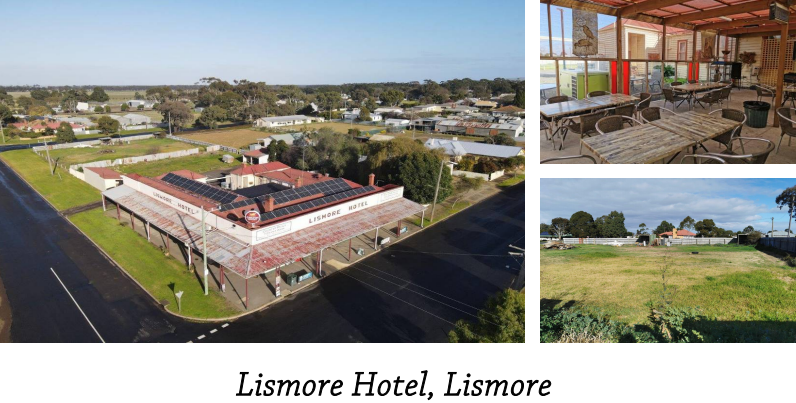Lismore victoria history and Early Township Heritage Precinct
culture and heritage

HISTORY
Lismore was originally known as Brown’s Water Holes because it was located near watering holes on the Gala Estate originally
leased by John Brown.
The aborigines called the area Bongerimennin. In 1853 the township was renamed Lismore possibly after a town in
County Waterford, Ireland.
The township area and the suburban allotments were first surveyed by Robert D. Scott in 1852 and the plan of
the township was laid before the executive council and approved on the 4thof March 1853. This early plan
included the wide central High Street, which
later included a median strip. On the 28th of
September 1853 the first sale of town allotments was held at in Geelong. Twelve allotments were sold in the area bounded by
Addis, Ferrers, Gray and Cunningham Streets. Suburban allotments one to ten, which were offered the next day,
comprised an area of 69 acres north of the township.
The township was slow to develop and the White Swan Hotel, situated at the foot of the hill just over the bridge was Lismore’s first and
for many years its only building. It was pulled down in 1911 when a new hotel was constructed on another site. This is the Hotel
in the precinct located on the corner of High and Ferrars Streets.
The Lismore town centre was scattered from the early days with the earliest commercial
buildings scattered along High Street and Gray Street. In 1869 Charles Taylor erected a store, carpenter’s shop and dwelling in High Street
which stood on a block later occupied by Bustard’s store. Bustard’s Store, constructed
in 1910 was run by the Bustard family until May 1965. It was destroyed by fire along with Mrs Caldow’s fruit and confectionary business,
two disused shops and a billiard room on February 4th1970.
Mail delivery and passenger movement to ad from the township during the early days was by coach. In the 1850s George Currie and
Thomas Shaw Snr. ran the Currie and Shaw coach line from Geelong. The business used a stable located in Gray Street. The Western Stage Company who established a coach line between Geelong and Mortlake carrying mail and passengers twice a week replaced this coach line. This service was discontinued in 1885.
Lismore went through agrowth period between the late 1890s up until about 1915 due to closer settlement and the coming of the
railway in 1913 but it never developed into a major district centre or township.
In 1864 a store was established by James Parry in Gray Street. The store was moved to the corner of Ferrars and High Streets where
A. S. Liston built a new building in 1911. This is the former Bakery shop with attached
dwelling at 36 Ferrers Street included as part
of the precinct.
To the rear of the Bakery and residence is a brick and stone bakehouse.
The residence at the corner of Ferrers and High Street, also in the precinct operated as the Post Office from the 1880s up until 1914. It
was initially constructed as a residence in the early 1880s.
The town continued to develop slowly but steadily into the twentieth century with the commercial centre later focused around the
intersection of High and Heriot Streets after the new Post Office was constructed at this
intersection in 1924.
After the Second World War, several of the surrounding stations were taken over by the Soldier Settlement Commission. This brought
increased activity to the township but once again it did not develop as a major district centre.
DESCRIPTION
The Lismore Early Township Precinct contains three buildings located in a cluster at the junction of High Street and Ferrers Street at 1
High Street and 26and 36 Ferrers Street.
The layout of the buildings around a common area
forms what was likely to have been a town common and a place for gathering.
The buildings are united by their commercial use (or former commercial use) and represent an early focus of commercial and social
activity in the township of Lismore.
Generally the other commercial buildings in the township have continued to remain scattered, with the main focus for commercial activity today
Corangamite Heritage Study Stage 2Volume 2
Prepared by Ray Tonkin and Samantha Westbrooke29 occurring at the intersection of Heriot and High Streets.
The contributory properties have been selected as they are substantially intact examples of early buildings demonstrating the appearance of the township in the early twentieth century.
The timber framed and clad construction type, detailing and form visually unites the cluster of buildings. While the front elevations of the
Hotel are clad in fibre board, the rear and side sections of the building retain the weatherboard cladding similar to the other two
buildings.
The three buildings contain key features of their era including pitched roof forms in a combination of hips and gables(in the case of the Hotel this is to the rear of the building), corrugated iron roof cladding, front skillion roofed verandahs and timber framed double hung windows. Both the former Bakery
and the hotel have pitched roofs concealed behind simple tall square parapets clad in flat metal sheet.
To the rear of the former Bakery is a brick and stone bakehouse, which has been partially concealed by vegetation.
STATEMENT OF CULTURAL HERITAGE
SIGNIFICANCE
What is significant?The Lismore Early Township Precinct contains three buildings located at the junction of High Street and Ferrers Street at 1 High Street and 26 and 36 Ferrers Street and including the median strip, Lismore.
How is it significant?
The Lismore Early Township Precinct is of local historic, aesthetic and social significance to the Shire of Corangamite.
Why is it significant?The Lismore Early Township Precinct is
historically significant for its representation of the former commercial centre of the early
township of Lismore. The precinct demonstrates the main period of activity in the town between the late 1890s up until about 1915 due to closer settlement and the coming of the railway in 1913. The buildings are rare surviving examples of early commercial
buildings in Lismore,with other early buildings demolished or destroyed by fire.
The brick and stone bakehouse to the rear of the former Bakery is significant as a rare surviving example of a bakehouse. (Criteria A & B)
The Lismore Early Township Precinct is aesthetically significant as it comprises of substantially intact examples of early commercial buildings demonstrating the early 20th century appearance of Lismore. The buildings retain key original features of their late 19thcentury and early 20thcentury construction erasincluding overall composition with pitched roofs and parapets, wall and roof cladding materials, timber framed openingand front verandahs.
The clustered layout of the buildings around a central common and
the unifying features of the buildings such as their forms, construction types and detailing, enhance theprecinct. (Criteria D & E)
The Lismore Early Township Precinct is of social significance to the Shire of Corangamite as a social and community gathering place for the Lismore community and people from the immediate surrounding districts.
The nature of the gathering place is emphasised by the layout of the three buildings around what was
likely to be a township common. (Criterion G)
REFERENCES
McAlpine, R. A., The Shire of Hampden 1863
–
1963, Hampden Shire Council, 1963
Oman, J. R. & Lang, P. S., Browns
Water
Holes. History of Lismore 1840
-
1980, J. R.
Oman ‘Rockbank”, Lismore, 1980
INDIVIDUAL DESCRIPTIONS AND
SIGNIFICANCE
Former Post Office, 26 Ferrers Street
Corangamite Heritage Study Stage 2Volume 2
Prepared by Ray Tonkin and Samantha West brooke 30 Victorian weatherboard residence constructed circa 1880. This building operated as the Post Office from the 1880s until 1914. The building is double fronted with a gable wing at either end with a central verandah wing in between the two gable wings. The roof is clad in corrugated iron.
The central verandah has a skillion profile roof. Window s are timber framed and double hung. There is a single entry door under the verandah to one end and twin double hung windows to the other end.
The building is historically and aesthetically significant for its operation as the Lismore Post Office from the 1880s until 1914. The building is substantially intact from its construction in the 1880s and is a rare surviving example of a commercial building in the early township of Lismore.
Former Bakery, 36 Ferrers Street
Victorian weatherboard shop and residence constructed in 1911. This building comprises a single fronted shop built to the street boundary and an attached residence to one side set back from the street. The shop has a single
entry door to one side and a large shop window comprising most of the front elevation.
There is a wide skillion roofed verandah to the front over the footpath and a tall square parapet clad in flat metal sheet. The parapet contains the remnants of painted advertising. The residence has a tall hipped roof with a verandah to the front.The front elevation comprises a single front door entry and a large tripartite timber framed double hung window. The building was in poor condition in February 2012. At the rear of the shop is a brick and stone bakehouse ,which is in a dilapidated state and has been partially concealed by vegetation.
The building is historically and aesthetically significant for its operation as an early suriving example of a commercial business in Lismore. The building is substantially intact from its construction in 1911 and is a rare surviving remnant of early Lismore, indicating the early location and appearance of the Lismore township centre.
Lismore Hotel, 1 High Street
The Lismore Hotel was constructed in 1911. It is a corner timber framed building with a tall flat parapet clad in flat metal sheet and a skillion roofed verandah to both frontages. The front elevations of the building are clad in fibre board sheets but the remainder of the building including a residence to the rear is clad n horizontal weatherboards. The front elevations contain evenly spaced timber framed double hung windows. The corner of the building is angled and contains a door leading to the bar. There are also single entry doors located on the two main elevations.
The rear of the building comprises weatherboard clad wings with hipped roofs clad in corrugated iron. These wings also contain timber framed, double hung windows. The residence to the rear has a verandah facing the yard to the rear.
The Lismore Hotel is historically, aesthetically and socially significant for its operation as the local hotel in Lismore since 1911. The building is
substantially intact from its construction and also retains the weatherboard Hotel residence to the rear. The building is important as a rare surviving commercial building indicating the early location and appearance of the Lismore township centre.


